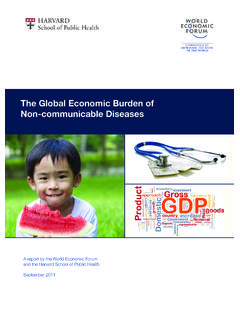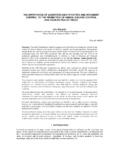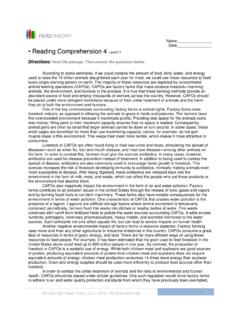Transcription of Public Policy and Health Promotion
1 Edmonton Social Planning Council DISCUSSION PAPER Creating Social and Health Equity: Adopting an Alberta Social Determinants of Health Framework By Philip O Hara ESPC Research and Policy Analysis Coordinator May 2005 Published and Distributed by the Edmonton Social Planning Council Available on-line at Creating Social and Health Equity Adopting an Alberta SDOH Framework ESPC May 2005 11. Introduction Our view of what makes us healthy is evolving. There is mounting evidence that the contribution of medicine and Health care is quite limited, and as a result, spending more on Health care will not result in significant further improvements in the Health of Albertans. On the other hand, there are strong and growing indications that other key factors, or determinants of health1, such as income and social environments, are the primary influencers on population Health ( Health Canada, 2004).
2 The challenge facing Alberta government decision makers is that most influences on the Health of Albertans originate outside the Health care system. Some experts estimate that the social and economic environments contribute to 50% of a population s Health status (Chart 1), while the illness care system contributes only 25% (Canadian Institute for Advanced Research, Health Canada, 2002). The Alberta government will be unable to meet its Health targets if it continues to allocate billions of dollars to a Health care system that is unable to deliver the necessary Health outcomes. This paper envisions the adoption of an Alberta Social Determinants of Health (SDOH) Framework that will improve the Health of individuals and all Albertans. The development of this framework is an important step leading to significant Health care reform in Alberta.
3 The adoption of this framework would represent an important shift in emphasis from an illness based Health care system (characterized by a focus on acute care) to a wellness-based system that focuses on preventing illness and chronic disease by addressing the social determinants of Health . 1 Different Health organizations use the terms determinants of Health ( Health Canada) and social determinants of Health (World Health Organization), yet typically, the terms include similar factors and have similar meanings. Others argue that the more appropriate terms are societal determinants of Health or socio-economic determinants of Health . In this paper, the term social determinants of Health is used. Creating Social and Health Equity Adopting an Alberta SDOH Framework ESPC May 2005 2In some respects, this shift is not as dramatic as it may appear.
4 The foundations for a SDOH Framework can be found in several Alberta government documents. For example, the Framework for a Healthy Alberta (2004) acknowledges the key influence of the determinants of Health . Similarly, Alberta s 2004 Report on Comparable Health Indicators (2005) stated, Our education, employment, income and physical environment influence our Health as much or more that the quality and availability of Health services . However, this shift would be a dramatic move from the status quo and would require strong political will to overcome the anticipated resistance. Resistance to the adoption of the SDOH Framework and the resulting Health care reforms would likely emerge from three sectors: 1) traditional Health care providers; 2) the Health care industry ( , medical suppliers); and 3) supporters of non-interventionist government.
5 It is hoped that this resistance would diminish as our understanding of what makes us healthy evolves and as a result of the inclusive and collaborative approaches taken to implement the SDOH Framework. Purpose of the Alberta SDOH Framework Make continual progress in advancing the Health of all Albertans through recognition of the important influence of the SDOH. Develop a greater understanding of the key influence of the SDOH among decision makers and Albertans. Develop an integrated, inclusive and multi-sectoral approach to addressing the SDOH in Alberta. Strengthen Health Promotion and population Health activities across the Health system, including strategies to address the SDOH in Alberta. Advance the concept of entitlement to basic social and economic rights based on the SDOH. Creating Social and Health Equity Adopting an Alberta SDOH Framework ESPC May 2005 32.
6 Social Determinants of Health Canada behind in addressing the SDOH A social determinants of Health approach is not a completely new development as it has its roots in critical examinations of the causes of illness and disease that date from the mid-nineteenth century. Over the past 35 years, British researchers have studied the sources of Health inequities among populations, which has contributed much to our understanding of the importance of social determinants of Health . More recently, Canadian researchers played a leading role in developing the concepts of Health Promotion and population Health , which helped to draw attention to the social determinants of Health (Raphael, 2004). Key Concepts Defined The following are definitions of the key concepts in this paper: Social Determinants of Health The SDOH are the economic and social conditions that influence the Health of individuals, communities and jurisdictions as a whole (Raphael 2004:1).
7 They are the conditions in which people live and work. They are the causes behind the causes of ill- Health (World Health Organization 2005:1). Finally, SDOH refers to both specific features of and pathways by which societal conditions affect Health and that potentially can be altered by informed action (Krieger 2001:693). Population Health Population Health is a social and political concept aimed at improving Health , prolonging life and enhancing quality of life among whole populations through Health Promotion , disease prevention and other forms of Health intervention (Chronic Disease Prevention Alliance of Canada, 2002). Health Promotion According to the Ottawa Charter, Health Promotion is a process of enabling people to increase control over and to improve their Health . It focuses on enhancing the capacities of individuals and communities to enable them to make healthy choices and to develop healthy and supportive environments (World Health Organization, 1998).
8 Creating Social and Health Equity Adopting an Alberta SDOH Framework ESPC May 2005 4 Unfortunately, according to the Canadian Population Health Institute, Canada has fallen behind countries such as the United Kingdom and Sweden, and even some jurisdictions in the United States, in applying the population Health knowledge base that has been largely developed in Canada (CPHI, 2003). Raphael (2004) notes his surprise at Canada s shortcomings in addressing the social determinants of Health given the tremendous increase in our knowledge about how economic and social conditions determine Health . He argues that for the most part, Policy -makers, the media and the general Public are badly informed about these issues. 2 Why the SDOH Matter A wealth of evidence from Canada and other countries supports the concept that the socioeconomic circumstances of individuals and groups are equally or more important to Health status than are medical care and personal Health behaviours, such as smoking (Evans et al.)
9 , 1994; Frank, 1995; Federal/Provincial/Territorial Advisory Committee on Population Health , 1999). The weight of evidence suggests that the SDOH 1) have a direct impact on the Health of individuals and populations, 2) are the best predictors of individual and population Health , 3) structure lifestyle choices, and 4) interact with each other to produce Health (Raphael, 2003). In particular, disparities the size of the gap or inequality in social and economic status between groups within a give population greatly affect the Health status of the whole. The larger the gap is, the lower the Health status of the overall population (Wilkinson, 1996; Wilkinson and Marmot, 1998). 2 Results of a 2005 survey conducted by the Canadian Institute for Health Information showed that Canadians generally believed that making lifestyle changes could improve Health to a much greater extent than could the social determinants of Health .
10 Media analysis in the survey showed that very few newspaper stories dealt with such determinants as housing, employment, and income distribution (Canadian Institute for Health Information, 2005). Creating Social and Health Equity Adopting an Alberta SDOH Framework ESPC May 2005 5As noted previously and shown in Chart 1, experts estimate that the social and economic environments contribute to 50% of a population s Health status, while the illness care system contributes only 25% (Canadian Institute for Advanced Research, Health Canada, 2002). Yet in the period 1997-00, regional Health authorities in Alberta consistently spent only about 3% of their budgets on Promotion , prevention and protection initiatives (Report of the Premier s Council of Health Care, 2002). Chart 1 Estimated Impact of Determinants of Health on Health Status of the Population Source: Canadian Institute for Advanced Research, Health Canada, Population and Public Health Branch AB/NWT 2002.

















